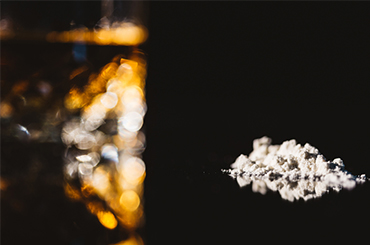- How Common is Mixing Cocaine and Alcohol?
- Effects of Combining Cocaine and Alcohol
- Why Do Some Users Combine Cocaine with Alcohol?
- Treatment for Cocaine and Alcohol Addiction
- Associated Social and Mental Health Problems
- Sources
Why Do People Combine Alcohol & Cocaine?
Frequently, an individual’s motivation to combine cocaine and alcohol is to:

Mixing of alcohol and cocaine results in the production of a blood-circulated metabolite called cocaethylene, which has a higher addictive potential than either drug alone.
Studies show that individuals who are both alcohol and cocaine dependent have severe psychosocial difficulties and exhibit poorer treatment outcomes than those who are dependent on either alone.
How Common is Mixing Cocaine and Alcohol?
Concurrent use of cocaine and alcohol is well documented.

In a study conducted in the U.S., more than 40 percent of cocaine dependent individuals reported lifetime alcohol use, some studies indicate that the comorbidity is as high as 60%.
Studies have reported that up to 70 percent of adolescents who used cocaine for the first time did so while simultaneously under the influence of alcohol.
- Additionally, use of cocaine by heavy drinkers can lead to a fourfold increase in the chance of developing alcohol dependence.
- Alcoholism is associated with adverse effects of cocaine consumption.
Cocaine & Alcohol Deaths
A report published by the Drug Abuse Warning Network (DAWN) suggested that approximately 32 percent of all drug abuse Emergency Department (ED) visits in 2009 involved the use of alcohol. Cocaine was the single most common illicit drug found in these individuals during toxicology screening.
- Concurrent use of alcohol and cocaine is also associated with an increased likelihood of suicidal and homicidal behavior.
- Cocaethylene increases the risk of sudden death by 18 to 25%, primarily due to its cardiotoxic effects.
Effects of Combining Cocaine and Alcohol
Mixing alcohol and cocaine can lead to the following:
- The simultaneous metabolism of cocaine can lead to the rise in blood alcohol concentration (BAC) after consuming alcoholic drinks.
2. Both a real and subjectively perceived decrease in the level of inebriation and lethargy otherwise brought about by alcohol use on its own.
 Find Treatment Now
Treating alcohol and cocaine abuse requires more intense management and the path to recovery can be more challenging.
3. Alcohol, on the other hand, potentiates the psychological effect of cocaine, enhancing the euphoria caused by it.
Find Treatment Now
Treating alcohol and cocaine abuse requires more intense management and the path to recovery can be more challenging.
3. Alcohol, on the other hand, potentiates the psychological effect of cocaine, enhancing the euphoria caused by it.
3. Production of cocaethylene—a molecule with properties similar to cocaine but tends to persist longer in the blood.
Some reports suggest that cocaethylene might be responsible for the increased cardiotoxicity that is associated with concurrent cocaine and alcohol use.
4. Use of more than one drug is commonly associated with relatively greater adverse effects and poorer treatment outcomes.
5. Quite understandably, since one has to deal with the dual problems of both cocaine and alcohol use, it can require more intense management and the path to recovery can be more challenging.
Studies have reported that the presence of lifetime alcohol dependence is associated with greater severity of cocaine dependence.
Why Do Some Users Combine Cocaine with Alcohol?
Research has explored the reasons behind people combining cocaine and alcohol. Here are a few of the most commonly cited reasons:
- Use of cocaine in combination with alcohol produces an increased and prolonged subjective pleasurable state compared with the use of either substance alone.
- In fact, it has been shown that use of cocaine in combination with alcohol leads to a 30 percent increase in cocaine blood concentrations.
- Cocaine mitigates the sedating effects of alcohol.
- Alcohol reduces the discomfort when coming down from cocaine
- Cocaine users report a greater and longer euphoria with concurrent use of alcohol—a finding that has been observed in research.
Further, the metabolite cocaethylene (as described earlier) shares similarities with cocaine and tends to have a longer duration of action.
Treatment for Cocaine and Alcohol Addiction
There are a number of options when it comes to the management of simultaneous cocaine and alcohol abuse problems—both with regard to treatment modalities and treatment settings.
Medical
![]() Acamprosate and naltrexone are two of the most commonly used anti-craving agents for the management of alcohol dependence.
Acamprosate and naltrexone are two of the most commonly used anti-craving agents for the management of alcohol dependence.
Disulfiram and topiramate have also been found to be effective in the long-term management of alcohol dependence.
Based on the effectiveness for both alcohol and, to a lesser extent, cocaine dependence, there is some support for the use of disulfiram and naltrexone in these individuals.
![]()
Psychological
Various psychological interventions that have been found to be effective in the management of alcohol and cocaine dependence include:
- Cognitive Behavioral Therapy (CBT).
- Motivational Enhancement Therapy (MET).
- Contingency Management (CM).
- 12 step facilitation.
Cognitive Behavioral Therapy (CBT), Contingency Management (CM) and 12 step facilitation have been recommended for those with combined use of cocaine and alcohol.
Inpatient
The inpatient setting offers longer periods of direct contact with a treatment team and the restricted environment makes it relatively easy to stay away from the drugs.
Outpatient
Associated Social and Mental Health Problems
Concurrent alcohol and cocaine dependence is correlated with more severe mental health issues and, potentially, more examples of social delinquency.
- Concurrent alcohol and cocaine use is correlated with an increased engagement in criminal activities.
- While the exact causal factors have not been determined; severe mental health profiles, a lack of social support and financial hardships are important contributors.
- There is an increased risk of engaging in homicidal and suicidal behavior.
- More severe psychological problems than non-alcoholic cocaine users.
- Larger impairments in the performance of neurobehavioral and neurocognitive tasks.
However, these findings have also been contradicted by some other studies, so further research is warranted.
Sources
[1] M. Gossop, V. Manning, and G. Ridge, “Concurrent use of alcohol and cocaine: differences in patterns of use and problems among users of crack cocaine and cocaine powder,” Alcohol Alcohol., vol. 41, pp. 121–125, 2006.
[2] H. R. Sumnall, G. F. Wagstaff, and J. C. Cole, “Self-reported psychopathology in polydrug users,” J. Psychopharmacol., vol. 18, pp. 75–82, 2004.
[3] M. Graziani, P. Nencini, and R. Nisticò, “Genders and the concurrent use of cocaine and alcohol: Pharmacological aspects,” Pharmacol. Res., vol. 87, pp. 60–70, 2014.
[4] L. J. Bierut, J. R. Strickland, J. R. Thompson, S. E. Afful, and L. B. Cottler, “Drug use and dependence in cocaine dependent subjects, community-based individuals, and their siblings,” Drug Alcohol Depend., vol. 95, pp. 14–22, 2008.
[5] T. Apantaku-Olajide, C. D. Darker, and B. P. Smyth, “Onset of cocaine use: Associated alcohol intoxication and psychosocial characteristics among adolescents in substance abuse treatment,” J. Addict. Med., vol. 7, pp. 183–188, 2013.
[6] G. Rubio, J. Manzanares, M. Jiménez, R. Rodriguez-Jimenez, I. Martínez, M. M. Iribarren, M. A. Jimenez-Arriero, G. Ponce, and T. Palomo, “Use of cocaine by heavy drinkers increases vulnerability to developing alcohol dependence: a 4-year follow-up study,” J. Clin. Psychiatry, vol. 69, 2008.
[7] I. M. Salloum, D. C. Daley, J. R. Cornelius, L. Kirisci, and M. E. Thase, “Disproportionate lethality in psychiatric patients with concurrent alcohol and cocaine abuse,” Am. J. Psychiatry, vol. 153, pp. 953–955, 1996.
[8] P. Andrews, “Cocaethylene toxicity,” J. Addict. Dis., vol. 16, pp. 75–84, 1997.
[9] E. J. Pennings, A. P. Leccese, and F. A. de Wolff, “Effects of concurrent use of alcohol and cocaine,” Addiction, vol. 97, pp. 773–783, 2002.
[10] J. Cami, M. Farré, M. L. González, J. Segura, and R. de la Torre, “Cocaine Metabolism in Humans after Use of Alcohol Clinical and Research Implications.” Springer, pp. 437–455, 1998.
[11] P. Jatlow, E. F. McCance, C. W. Bradberry, J. D. Elsworth, J. R. Taylor, and R. H. Roth, “Alcohol plus cocaine: the whole is more than the sum of its parts,” Ther. drug Monit., vol. 18, pp. 460–464, 1996.
[12] K. M. Carroll, B. J. Rounsaville, and K. J. Bryant, “Alcoholism in treatment-seeking cocaine abusers: clinical and prognostic significance.,” J. Stud. Alcohol, vol. 54, pp. 199–208, 1993.
[13] D. S. Harris, E. T. Everhart, J. Mendelson, and R. T. Jones, “The pharmacology of cocaethylene in humans following cocaine and ethanol administration,” Drug Alcohol Depend., vol. 72, pp. 169–182, 2003.
[14] M. Farré, R. De La Torre, M. L. González, M. T. Terán, P. N. Roset, E. Menoyo, and J. Camí, “Cocaine and alcohol interactions in humans: neuroendocrine effects and cocaethylene metabolism,” J. Pharmacol. Exp. Ther., vol. 283, pp. 164–176, 1997.
[15] P. Assessment, “Treatment of co-occurring alcohol and other drug use disorders,” 2008.
[16] L. Karila, D. Gorelick, A. Weinstein, F. Noble, A. Benyamina, S. Coscas, L. Blecha, W. Lowenstein, J. L. Martinot, and M. Reynaud, “New treatments for cocaine dependence: a focused review,” Int. J. Neuropsychopharmacol., vol. 11, pp. 425–438, 2008.
[17] F. J. Vocci and A. Elkashef, “Pharmacotherapy and other treatments for cocaine abuse and dependence,” Curr. Opin. Psychiatry, vol. 18, pp. 265–270, 2005.
[18] H. M. Pettinati, J. R. Volpicelli, J. D. Pierce Jr, and C. P. O’brien, “Improving naltrexone response: an intervention for medical practitioners to enhance medication compliance in alcohol dependent patients,” J. Addict. Dis., vol. 19, pp. 71–83, 2000.
[19] K. M. Carroll, B. J. Rounsaville, and K. J. Bryant, “Alcoholism in treatment-seeking cocaine abusers: clinical and prognostic significance.,” J. Stud. Alcohol, vol. 54, pp. 199–208, 1993.
[20] K. I. Bolla, F. R. Funderburk, and J. L. Cadet, “Differential effects of cocaine and cocaine alcohol on neurocognitive performance,” Neurology, vol. 54, pp. 2285–2292, 2000.
[21] M. J. Selby and R. L. Azrin, “Neuropsychological functioning in drug abusers,” Drug Alcohol Depend., vol. 50, pp. 39–45, 1998.
[22] R. F. Rasch, C. A. Weisen, B. MacDonald, W. M. Wechsberg, R. Perritt, and M. L. Dennis, “Patterns of HIV risk and alcohol use among African-American crack abusers,” Drug Alcohol Depend., vol. 58, pp. 259–266, 2000.
